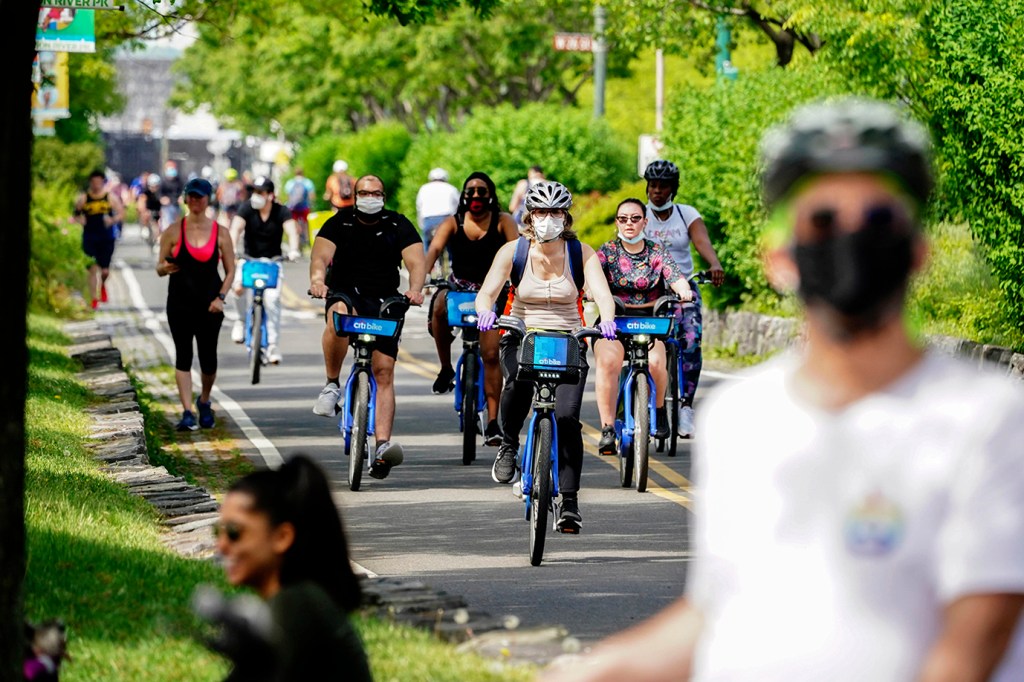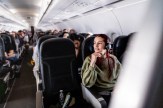People in the US started moving around more before stay-at-home measures were lifted

Every state in the U.S. is starting to relax stay-at-home guidelines and allow businesses to reopen. But even before the vast majority of states were loosening the measures intended to keep people physically distant and slow the spread of the coronavirus, people were starting to travel further and see each other more, according to research from Northeastern’s Network Science Institute.
“You start to see a gradual incline in early May, sort of following when the federal physical distancing guidelines were not renewed,” says Brennan Klein, a fifth-year doctoral student who helped analyze location data from millions of mobile devices.

Matteo Chinazzi is an associate research scientist in the Network Science Institute at Northeastern. Photo by Matthew Modoono/Northeastern University
As of late April, the average person in the United States had reduced their daily mobility between 45 and 55 percent, the researchers found, and the number of people who were in contact with at least one other person outside their home had decreased by between 65 and 75 percent. The recent uptick is small, nowhere near pre-pandemic levels, but the group is continuing to update the data on a public dashboard to help people visualize what is going on in their own states.
“The point is to understand whether this curve will keep increasing,” says Matteo Chinazzi, an associate research scientist in the Network Science Institute. “To see if these behaviors will actually go back to normal, or if it just means there is a bit more activity compared to what we had with the stay-at-home policies, but still very far from what would be typical.”
This data also helps to guide models predicting how the disease will spread, which many governors and public health officials are using to guide their decisions.
“You can plug our numbers into your epidemic model of choice to kind of benchmark reality,” Chinazzi says. “You can look at the real data and say, ‘Okay, for the city of Boston or for Seattle, I know that this is what happened.’”
The location data was provided by Cuebiq, a company that collects GPS data from the mobile devices of users who have given their consent. That data is anonymized, and excludes members of vulnerable populations such as minors or incarcerated individuals, but still provides the ability to analyze large-scale mobility patterns.
“Mobility data is really powerful for some of these big picture insights on how people move, not only during normal times, but also during epidemics or pandemics like COVID-19, and also how people respond at an aggregate scale to containment strategies like social distancing or sheltering in place,” says Brennan Lake, who directs Cuebiq’s Data for Good program.
The researchers tracked five metrics to understand how people are moving in the United States. On the individual level, they measured how far the average person traveled from their usual area, how many people had at least one contact in a day, and how often two people were in the same location. On a regional level, the researchers measured the daily commute volume and transit between major urban areas. Of these, only daily commute volume has not increased since the beginning of May.
But just because people are moving around more doesn’t necessarily mean that they’re being unsafe.
For example, the researchers track what they call ‘co-location events,’ which means that two mobile devices are within 60 feet of each other within a five-minute window. While that’s a pretty good proxy for the number of contacts, it doesn’t tell us what those people were doing.
“If I go for a walk with Brennan, and we walk around the Chestnut Hill Reservoir for 30 minutes, that would be us being in the same location six different times,” says Stefan McCabe, another of the doctoral students who have been pouring their time and energy into this project. “These are not necessarily going to be contacts in the sense of violating the social norms around staying six feet apart from each other.”
Wearing masks, meeting outside with small numbers of people, and keeping your distance can help minimize the risks inherent in leaving your house, according to public health officials. If people are traveling slightly further and seeing slightly more people, these safeguards could make a difference.
“Not all mobility increases are created equal,” McCabe says. “And they’re definitely not all bad, per se. Going about life under this, to use the cliché, ‘new normal’ is a learning process.”
For media inquiries, please contact Jessica Hair at j.hair@northeastern.edu or 617-373-5718.





